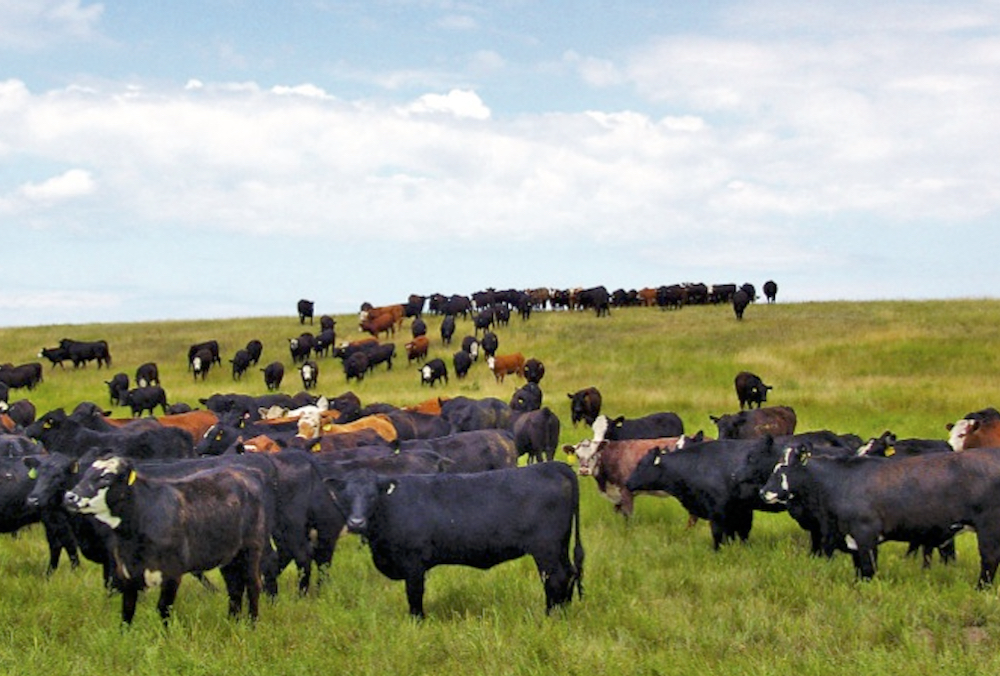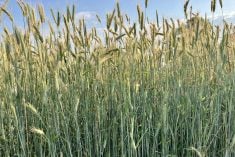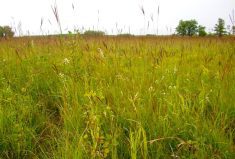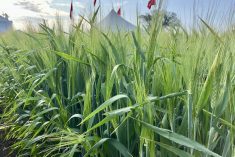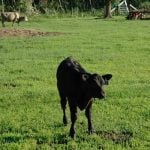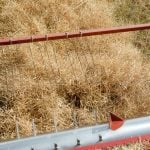A noxious weed is an invasive non-native species that may reduce the yield of existing crops and forages if not controlled through herbicide application or by other means. Many weed species can be consumed by cattle and provide nutritive value during drought-induced feed shortages, while at the same time reducing herbicide use.
Kochia (Bassia scoparia) is an annual broadleaf weed that is becoming increasingly problematic due to its resistance to several herbicides including glyphosate and its tumbleweed nature which results in its rapid spread within and among fields. As a result, glyphosate does not control resistant kochia in glyphosate-tolerant crops such as canola, corn or soybean. Furthermore, kochia remains green during senescence, making it difficult to harvest crops that are heavily contaminated with this weed. Strips of glyphosate-resistant kochia in the field mark the direction that this tumbleweed rolled through the field, often coming to a stop where it hit an outer fence or ended up in the ditch. Removing dense kochia patches could aid harvest operations while generating an alternative feed source for cattle.
[RELATED] VIDEO: What does a healthy pasture look like?
Read Also

Finding greater value through controlled creep feeding of beef calves
Gerard Roney, founder of Advantage Feeders in Australia, spoke at Ag in Motion 2025 about using controlled creep feeding to develop a calf’s rumen, allowing for better uptake of energy and protein at a younger age, along with other beneficial applications of creep feeding.
Researchers at the Lethbridge Research and Development Centre from AAFC conducted a laboratory study to evaluate the nutritional value of both herbicide-resistant and susceptible kochia, either treated or not treated with herbicides. For the most part, harvest date had a much greater impact on the feed value of kochia than if it was herbicide-resistant or treated with herbicides. Although the yield of kochia increased with advancing maturity, its protein content and digestibility decreased. As a result, harvesting kochia at the vegetative stage maximized its feed value.
Another added value of harvesting before flowering is that the forage will be consumed before weed seeds are formed. Cattle can spread weed seeds that remain viable after passage through their digestive tract or by seeds that adhere to their hides. If the kochia is mature at harvest, grinding or pelleting may reduce seed viability, but it is unlikely to eliminate it.
Others have shown that kochia is a palatable forage with a nutritional value that is comparable to alfalfa. Kochia grows well in saline soils under dry conditions, making it a viable emergency forage source during feed shortages. Kochia can be harvested and dried as hay, mixed with other forages, or ensiled as a replacement for alfalfa silage.
[RELATED] Living with leafy spurge
A variety of other noxious weed species have also been deemed as safe alternative forages for cattle to graze if some precautions are considered. Lamb’s quarters, redroot pigweed, Canada thistle, spotted and diffuse knapweeds and cheatgrass are invasive weed species that can also serve as forage for cattle. Weed seed dispersion can be avoided and the greatest nutritional value obtained if these weeds are also consumed by cattle in the vegetative stage. These weeds can vary considerably in their protein content and digestibility, so testing their nutrient composition can help ensure that diets that meet the nutrient requirements for cattle are formulated. Other potential toxins such as high levels of nitrate in Canada thistle or oxalic acids in lamb’s quarters could also be assessed to ensure that they are not present at toxic levels.
Cattle and other ruminants may need to go through an adaptation phase to recognize weed species as palatable forage sources. Researchers from Montana State University successfully trained yearlings and cow-calf pairs to consume spotted knapweed and Canadian thistle. Half of the cattle from each group were selected for training to investigate whether social learning within the herd could influence the grazing behaviour of untrained cattle. This was accomplished by feeding cattle an unfamiliar nutritious food (e.g. flaked corn, soybean meal, rolled oats, alfalfa pellets, range cubes, etc.) with various flavours and textures in feeders in the morning and afternoon for four days. For the next three days, the morning feeding was skipped to ensure the cattle were hungry and feed provided in the afternoon was mixed with clippings of spotted knapweed and Canada thistle before being fed. Both groups retained training and all herd members were observed grazing spotted knapweed and Canada thistle upon return to the pasture. These results indicate that social learning, in addition to maternal influence, may affect grazing behaviour.
Various mechanisms are responsible for determining forage selection. Calves initially learn which forages are palatable by observing the grazing behaviour of maternal cows and other herd members. Post-ingestive feedback affects feed selection based on nutritional and toxicological consequences, affecting future forage selection based on physical and chemical characteristics (e.g. sight, smell and taste). Forages with sufficient nutrients that provide satiety will be deemed as palatable, promoting intake and consumption upon future encounters. Once a herd learns to recognize weeds as palatable feeds, it can serve as a sustainable long-term solution for weed management.
Selecting the livestock species most suitable to remove the targeted weed species may also be a consideration. For example, goats are better able to detoxify many of the potential secondary compounds (e.g. tannins, terpenes and oxalates) in some weed species than cattle. Goats possess an enhanced capacity to detoxify tannins as they can host microbes in the rumen that are better at degrading them and they have proteins in their saliva that reduce their toxicity.
The invasion of noxious weeds within rangelands can have a substantial impact on forage yield and quality, reducing the pasture’s grazing capacity. Training cattle to consume weeds may serve as a sustainable solution for controlling infestations and reducing reliance on herbicides. Grazing should be targeted to optimize palatability and maximize damage to targeted weeds while avoiding toxic repercussions. Effective grazing programs can reduce regeneration of undesirable weeds while at the same time acting as a forage source for cattle during periods of drought-induced shortages.
– Amanda Meadows is an M.Sc. student with Drs. Tim McAllister and Gabriel Ribeiro and is nearing the completion of her program.

